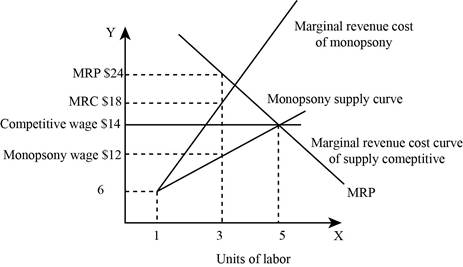
Concept explainers
Sub part (a):
The monopsony market.
Sub part (a):
Explanation of Solution
The total labor cost can be calculated by using the following formula.
Substitute the respective value in the equation (1) to calculate the total labor cost at one unit of labor.
The total labor cost is $3.
The marginal resource cost can be calculated by using the following formula.
Substitute the respective values in the equation (2) to calculate the marginal resource cost at one unit of labor.
The marginal resource cost is $3.
Table -1 shows the value of the total labor cost and the marginal resources cost that are obtained by using the equation (1) and (2).
Table -1
| Units of labor | Wage rate | Total labor cost | Marginal resources cost |
| 0 | - | 0 | |
| 1 | 6 | 6 | 6 |
| 2 | 9 | 18 | 12 |
| 3 | 12 | 36 | 18 |
| 4 | 15 | 60 | 24 |
| 5 | 18 | 90 | 30 |
| 6 | 21 | 120 | 36 |
The total revenue can be calculated by using the following formula.
The
Substitute the respective value in the equation (3) to calculate the total revenue at one unit of labor.
The total revenue is $34.
The marginal product can be calculated by using the following formula.
Substitute the respective values in the equation (4) to calculate the marginal resource cost at one unit of labor.
The marginal product is $17.
The marginal revenue product can be calculated by using the following formula.
The
Substitute the respective values in the equation (5) to calculate the marginal revenue product.
The marginal revenue product is $34.
Table -2 shows the value of the total revenue, the marginal revenue product and the marginal product that is obtained by using the equation (3), (4) and (5).
Table -2
| Units of labor | Total product | Marginal product | Product price | Total revenue | Marginal revenue product |
| 0 | 0 | 2 | 0 | ||
| 1 | 17 | 17 | 2 | 34 | 34 |
| 2 | 31 | 14 | 2 | 62 | 28 |
| 3 | 43 | 12 | 2 | 86 | 24 |
| 4 | 53 | 10 | 2 | 106 | 20 |
| 5 | 60 | 7 | 2 | 120 | 14 |
| 6 | 65 | 5 | 2 | 130 | 10 |
Graph -1 shows the firms labor supply and the marginal resources cost.7

In graph -1, the horizontal axis measures the units of labor and the vertical axis represents the wage rate. The discrete nature of problem requires that the (MRP) marginal revenue product should be equal or greater than the marginal resources cost. This marginal revenue cost curve lies above the labor supply because the employing of the next worker needs a higher wage in the market and will have to pay a higher wage for all the workers.
Concept introduction:
Monopsony: The monopsony market refers to a market which consists of a single buyer who hires a particular type of labor. The workers provide labor to this type of market that has a limited employment opportunity as they need to acquire new skills to be hired. The firm is the wage marker.
Subpart (b):
How many workers should the firm employ.
Subpart (b):
Answer to Problem 3P
The firm should employ 3 workers.
Explanation of Solution
When the marginal revenue product for this worker is greater than the marginal cost, then the firm should employ the workers. From the table, the firm should employ three workers. For the first worker, the marginal revenue product is $34 and the marginal revenue cost is $6. Thus, the firm should employ the first worker. For the second worker, the marginal revenue product is $28 and the marginal revenue cost is $12. So, the firm should employ the second worker. For the third worker, the marginal revenue product is $24 and the marginal revenue cost is $18. So the firm should employ the third worker. But for the fourth worker, the marginal revenue product is $20 and the marginal revenue cost is $24. So, the firm should not employ the forth worker.
Subpart (c):
What happens to the monopolist employment and equilibrium wage rate.
Subpart (c):
Explanation of Solution
In this, the monopolist employment decreases by 2 units and the equilibrium wage rate is $2 which is less than the competitive wage.
Want to see more full solutions like this?
Chapter 15 Solutions
Economics: Principles, Problems, & Policies (McGraw-Hill Series in Economics) - Standalone book
- ??!!arrow_forward. What the heck is this GDP thingy? It is Thursday afternoon, just a few days before the holiday season starts in your region, and you decided to visit your uncle Chao who owns a local delivery company. While sitting in the living room watching the evening news with your uncle, you heard the news reporter stating the following with an optimistic tone: "According to recent studies, gross domestic product (GDP) is rising due to an increase in consumer spending. The increase in spending was due to an increase in consumer confidence because the job market has shown a positive increase in both employment and income." Immediately, your uncle Chao looked at you with some confusion on his face and asked: What the heck is GDP, and why does the news dude seem excited about its increase? Does this “good” change in this GDP thingy have any effect on my delivery business? How? Do I need to do something different to prepare for the rise in GDP? How?arrow_forward3. I need people who don’t want me! As an operations manager at a factory that produces manual tools, you were tasked with preparing a new site for expansion. The plan is to start production in the new location within 6 months from the current date. The new location requires 100 workers to operate fully. The workers you need don’t require any form of education or special skills because the tasks at the factory are simple and straightforward. In other words, you typically hire lower-skilled workers. In recent years, your company has been having problems finding workers who meet those criteria because the demand for them is so high. While sitting in your office, your teammate, Alejandra, walked to your office and said, "Have you heard the recent news about the economy? They said that investment has declined, and government spending has declined too. They also said that GDP is expected to shrink in the next 6 to 10 months. I wonder what is next." Then, she looked at you and said: How…arrow_forward
- X Apex Learning Courses public activity 003002 assessment K! Kahoot! 11.3.2 Quiz: Specialization Question 5 of 10 Which term describes a business's decision to focus on producing a small number of products? A. Opportunity cost B. Specialization C. Voluntary exchange D. Self-sufficiency PREVIOUS SUBMITarrow_forwardApex Learning Apex Learning Courses leaming.com/public/activity/1003002/assessment QQuizlet K! Kahoot! 1.3.2 Quiz: Specialization Question 5 of 10 Which term describes a business's decision to focus on producing a small number of products? OO A. Opportunity cost B. Specialization C. Voluntary exchange D. Self-sufficiency PREVIOUS SUBMITarrow_forwardnot use ai pleasearrow_forward

 Principles of Economics 2eEconomicsISBN:9781947172364Author:Steven A. Greenlaw; David ShapiroPublisher:OpenStax
Principles of Economics 2eEconomicsISBN:9781947172364Author:Steven A. Greenlaw; David ShapiroPublisher:OpenStax Managerial Economics: Applications, Strategies an...EconomicsISBN:9781305506381Author:James R. McGuigan, R. Charles Moyer, Frederick H.deB. HarrisPublisher:Cengage Learning
Managerial Economics: Applications, Strategies an...EconomicsISBN:9781305506381Author:James R. McGuigan, R. Charles Moyer, Frederick H.deB. HarrisPublisher:Cengage Learning Principles of MicroeconomicsEconomicsISBN:9781305156050Author:N. Gregory MankiwPublisher:Cengage Learning
Principles of MicroeconomicsEconomicsISBN:9781305156050Author:N. Gregory MankiwPublisher:Cengage Learning Microeconomics: Private and Public Choice (MindTa...EconomicsISBN:9781305506893Author:James D. Gwartney, Richard L. Stroup, Russell S. Sobel, David A. MacphersonPublisher:Cengage Learning
Microeconomics: Private and Public Choice (MindTa...EconomicsISBN:9781305506893Author:James D. Gwartney, Richard L. Stroup, Russell S. Sobel, David A. MacphersonPublisher:Cengage Learning





